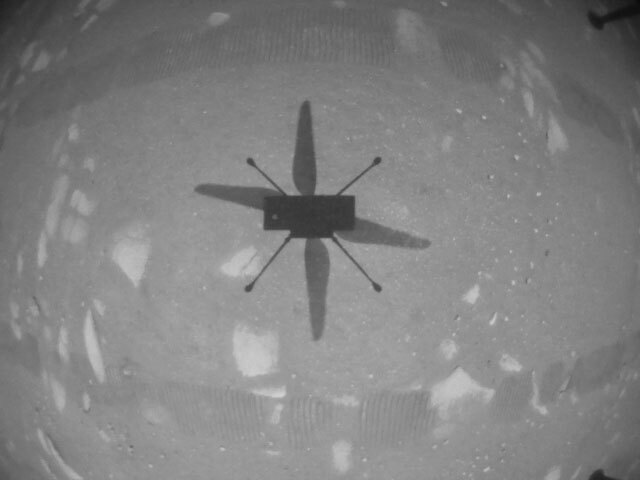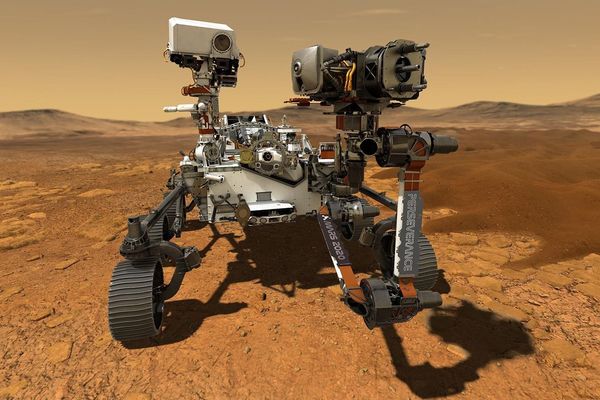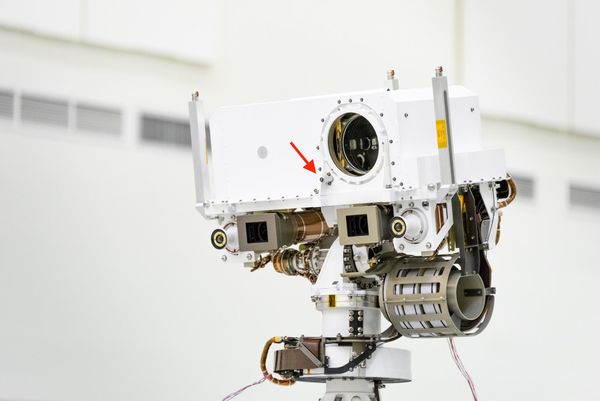
LATEST:
NEWS | April 19, 2021
NASA’s Ingenuity Mars Helicopter Succeeds in Historic First Flight
The small rotorcraft made history, hovering above Jezero Crater, demonstrating that powered, controlled flight on another planet is possible.
Monday, NASA’s Ingenuity Mars Helicopter became the first aircraft in history to make a powered, controlled flight on another planet. The Ingenuity team at the agency’s Jet Propulsion Laboratory in Southern California confirmed the flight succeeded after receiving data from the helicopter via NASA’s Perseverance Mars rover at 6:46 a.m. EDT (3:46 a.m. PDT).
“Ingenuity is the latest in a long and storied tradition of NASA projects achieving a space exploration goal once thought impossible,” said acting NASA Administrator Steve Jurczyk. “The X-15 was a pathfinder for the space shuttle. Mars Pathfinder and its Sojourner rover did the same for three generations of Mars rovers. We don’t know exactly where Ingenuity will lead us, but today’s results indicate the sky – at least on Mars – may not be the limit.” More: https://mars.nasa.gov/news/8923/nasas-ingenuity-mars-helicopter-succeeds-in-historic-first-flight/
NASA’s Mars helicopter Ingenuity successfully completed its historic first flight
https://edition.cnn.com/2021/04/19/world/mars-helicopter-ingenuity-first-flight-scn-trnd/index.html
NASA releases stunning new images from Mars
NASA provides an update on Perseverance rover’s “firsts” and milestones so far, as well as what’s next.
**************
Less than a day after NASA’s Mars 2020 Perseverance rover successfully landed on the surface of Mars, engineers and scientists at the agency’s Jet Propulsion Laboratory in Southern California were hard at work, awaiting the next transmissions from Perseverance. As data gradually came in, relayed by several spacecraft orbiting the Red Planet, the Perseverance team were relieved to see the rover’s health reports, which showed everything appeared to be working as expected.
Adding to the excitement was a high-resolution image taken during the rover’s landing. While NASA’s Mars Curiosity rover sent back a stop-motion movie of its descent, Perseverance’s cameras are intended to capture video of its touchdown and this new still image was taken from that footage, which is still being relayed to Earth and processed.
More: https://www.nasa.gov/press-release/nasa-s-perseverance-rover-sends-sneak-peek-of-mars-landing
Ingenuity helicopter phones home from Mars
(CNN) — The Ingenuity helicopter, sidekick and traveling companion of NASA’s Perseverance rover, has checked in with a good report and is “operating as expected,” according to the agency.
If successful, Ingenuity will be the first helicopter to fly on another planet, leading to an “extraterrestrial Wright Brothers moment,” said Thomas Zurbuchen, associate administrator of NASA’s Science Mission Directorate.
The rover landed safely on the surface of Mars Thursday after launching from Earth on July 30. Perseverance has already sent back an impressive set of images to show that she’s safe and ready to go through a “checkout” phase before starting her journey across the surface.
Now, the mission team has heard directly from the helicopter for the first time — and it’s good news.
Ingenuity is currently tucked up beneath the rover and attached to Perseverance’s belly. The rover is about the size of an SUV, while the helicopter only weighs about 4 pounds.
The helicopter was able to phone home via the rover by sending data back through NASA’s Mars Reconnaissance Orbiter, which acts as a communications relay between Mars and Earth and has been orbiting the red planet since 2006.
Ingenuity is comfortable where it is and isn’t letting go of the rover anytime soon for a test flight. The helicopter will remain snug with the rover for 30 to 60 days.
“Ingenuity, the Mars Helicopter I carry, is working as expected. I’m currently charging it, but once I set it down, it’ll rely solely on its solar panels. If it survives the brutally cold Martian nights, the team will attempt flight,” read a tweet from the Perseverance Twitter account.
“There are two big-ticket items we are looking for in the data: the state of charge of Ingenuity’s batteries as well as confirmation the base station is operating as designed, commanding heaters to turn off and on to keep the helicopter’s electronics within an expected range,” said Tim Canham, Ingenuity Mars Helicopter operations lead at NASA’s Jet Propulsion Laboratory, in a statement.
“Both appear to be working great. With this positive report, we will move forward with (Saturday’s) charge of the helicopter’s batteries.”
Ingenuity needs to power up and store energy so it can keep itself warm and maintain other vital functions during the cold Martian nights once the rover deposits the helicopter on the red planet’s surface. Then, Ingenuity will be on its own.
And it will need to withstand nights where temperatures can drop as low as negative 130 degrees Fahrenheit. As Elton John famously sings in “Rocket Man,” Mars is, indeed, as cold as hell.
Maintaining function and good battery health will be critical if the helicopter is to survive the frigid Martian climate before attempting any test flights later on. A total of five test flights are planned over a 31-day period once the rover finds the right “helipad,” or nice flat spot, to deposit Ingenuity.
As long as Ingenuity is attached to Perseverance, the helicopter can give its batteries a boost. The helicopter has six lithium-ion batteries. Once it has detached from the rover, those batteries will be charged by the helicopter’s solar panel.
The first flight of Ingenuity will be short, only about 20 seconds of hovering off the ground. But it will be a historic moment. Much like the very first Martian rover, Sojourner, Ingenuity is a technology demonstration — an experiment. Proving that this concept can work could lead to the development of rotorcraft that could act as scouts for both rovers and human missions to Mars in the future.
If that first flight is successful, “over 90% of the project’s goals will have been achieved,” according to NASA.
Subsequent flights could last longer and test out more of the helicopter’s capabilities. It carries two cameras that can provide aerial images. Perseverance will also train its cameras on Ingenuity to capture the sights and sounds, including video, of these historic flights.
“We are in uncharted territory, but this team is used to that,” said MiMi Aung, project manager for the Ingenuity Mars Helicopter at JPL, in a statement. “Just about every milestone from here through the end of our flight demonstration program will be a first, and each has to succeed for us to go on to the next. We’ll enjoy this good news for the moment, but then we have to get back to work.”
Links: https://edition.cnn.com/2021/02/20/world/mars-ingenuity-helicopter-update-scn-trnd/index.html
https://edition.cnn.com/2021/02/19/world/perseverance-rover-landing-joy-scn-trnd/index.html
*********************
Persévérance, le rover en route pour Mars, avec à son bord un micro développé à Toulouse
C’est ce 18 février 2021 que Persévérance atterrit sur Mars, 6 mois après son départ de la Terre. À bord du rover de la NASA, un microphone développé à Toulouse, par l’ISAE-SUPAERO. Ce micro a pour mission d’enregistrer les sons sur la planète rouge et c’est une première mondiale.

Peu avant 22h, ce 18 février, tous les yeux de la communauté scientifique seront braqués sur Mars. Le rover Persévérance arrivera au-dessus du cratère Jezero sur la planète rouge, après six mois de voyage. Gros défi pour la sonde qui devra, en seulement sept minutes, passer d’une vitesse de plus de 20 000km/h à zéro pour y déposer son chargement.
L’objectif de la mission Mars 2020 est de ramener des échantillons du sol de la planète Mars sur Terre pour permettre leur analyse.
Pour mener à bien sa mission, Persévérance sera doté d’outils encore plus perfectionnés que Curiosity.
SuperCam …. et Super micro
À commencer par SuperCam, la version améliorée de ChemCam, la caméra de Curiosity, pour pouvoir analyser les minéraux. Grâce à la technologie d’imagerie couleur haute-résolution qu’il embarque, l’instrument étudiera la chimie et la minéralogie des roches et des sols de Mars, ainsi que la composition de son atmosphère. La sonde pourra ainsi être guidée dans sa recherche d’échantillons pour assurer la meilleure sélection possible et déterminer s’il y a eu ou non de la vie sur la planète Mars.
Un micro adapté au spatial
Le rover Persévérance sera aussi doté d’un microphone très perfectionné, développé à Toulouse.

C’est environ deux à trois jours après l’atterrissage que le micro conçu par l’ISAE-SUPAERO commencera à enregistrer les sons martiens. Il s’agit là d’une première mondiale. Il y a déjà eu plusieurs tentatives d’embarquer un microphone à bord d’une mission vers Mars, toutes infructueuses, et c’est la première fois que la NASA en sélectionne un pour sa plus-value scientifique. Cela fait cinq ans qu’une équipe de cinq personnes de l’Isae-Supaero, l’une des meilleures écoles au monde en matière d’ingénierie aérospatiale, travaille sur ce projet.
Ce microphone est en fait un modèle “grand public” spécifiquement adapté pour résister à l’environnement martien. Comme l’indique David Mimoun, responsable scientifique du microphone et professeur à l’Isae-Supaero, “un certain nombre de composants ne sont pas compatibles avec le spatial, comme le “vide spatial”, les fortes amplitudes thermiques”.

Le micro doit être capable de tenir les -120°C tout comme les +60°C sans se dégrader. On l’a chauffé et refroidi plus de 1000 fois et passé aux radiations pour simuler le trajet fait entre la Terre et Mars.
David Mimoun ajoute qu'”une seconde adaptation a été nécessaire. Il a fallu un fil spécial pour le raccorder à SuperCam qui l’alimente. Le micro étant à l’extérieur du rover, le cable subit donc le froid intense à l’extérieur et le chaud à l’intérieur. Ce fil spécial conduit l’électricité mais pas la chaleur”. Par ailleurs des soudures très spécifiques ont été réalisées pour adapter le microphone à son environnement spatial.
Grâce à une calibration effectuée sur Terre, dans une chambre reproduisant les conditions « martiennes », les enregistrements effectués par le micro pourront aider les chercheurs de l’Isae-Supaero à caractériser les différents types de matériaux analysés par l’instrument SuperCam, en s’appuyant sur une collection de sons de référence.
Il faut savoir que le bruit sur Mars est fortement atténué et ne se propage pas. Les sons sont atténués de 20 dB par rapport à leur niveau sur Terre. Cela revient à une conversation à travers un mur de dix cm d’épaisseur.
Une double mission sur une décennie
La mission primaire de Perseverance durera environ 22 mois terrestres après l’atterrissage soit jusqu’au 6 janvier 2023. Tout temps supplémentaire sera du « bonus ». Il faut savoir que la mission Mars 2020 est le premier volet d’une mission en deux parties. Persévérance va, en premier lieu, collecter des informations et des échantillons. Et début 2030, un rover que l’on appelle “fetcher” ira chercher les échantillons pour les ramener sur Terre.
Et pour ceux qui s’interrogent… Quid de Curiosity ? Il continue son travail tant que sa santé le lui permet, maintenant épaulé par Persévérance, à l’oeuvre d’ici quelques jours sur sa mission d’envergure.




